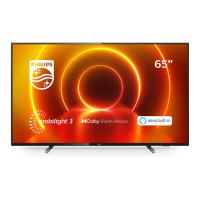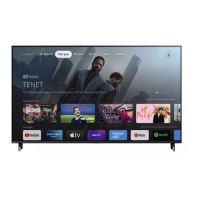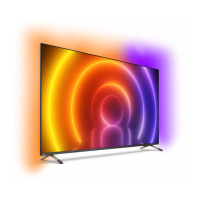Do you have a question about the Philips 65PUS8818 and is the answer not in the manual?
Emphasizes reading safety instructions before TV use.
Instructions for mounting the TV stand and wall bracket.
Detailed overview of buttons on remote control types 1 and 2.
Steps to pair the remote control using Bluetooth or IR.
How to use voice search after pairing the remote.
How to switch the TV on, put it in standby, and reboot.
Detailed steps for installing satellite channels and settings.
Steps to manually update digital channels.
Instructions for copying and uploading channel lists.
Steps for updating channels via antenna or cable.
How to reinstall all channels and settings.
Steps to upload a channel list to new or installed TVs.
Procedure to reset the TV to factory settings.
Features for deaf, hearing impaired, blind, or visually impaired users.
Creating, editing, and managing favourite channel lists.
Steps to lock and unlock channels, and parental rating settings.
Settings for HDMI Ultra HD for optimal display quality.
Connecting Home Theatre Systems via HDMI ARC/eARC.
Connecting smartphones/tablets wirelessly via Philips TV Remote App.
Connecting game consoles via HDMI.
Information on HDMI quality, HDCP, and ports.
Adjusting HDMI Ultra HD settings for optimal or standard quality.
Connecting a CAM module for conditional access.
Details on connecting devices via HDMI ARC/eARC.
Connecting a computer to use the TV as a monitor.
Connecting the TV to a home network and the internet.
Signing into a Google Account for TV features.
How to start and use the TV's internet browser.
Accessing and adjusting picture settings.
Advanced picture adjustments like contrast, brightness, and HDR.
Adjusting picture format to fill the screen.
Adjusting speaker virtualizer, clear dialogue, and AI equalizer.
Personalizing sound based on hearing ability.
Settings for volume control, delta volume, and Dolby Atmos.
Turning Ambilight on/off and selecting styles.
Using Ambilight, music, and weather for wake-up alarms.
Overview of the picture settings menu.
Configuring audio output to TV speakers or external systems.
Setting Ambilight to follow video, audio, or colour.
Selecting and customizing sound styles.
Settings for TV speakers and eARC mode.
Choosing preset sound styles for different content.
Calibrating TV speakers for optimal room sound.
Finding and installing apps from Google Play Store.
Renting movies and TV shows via Google TV app.
Features for deaf, hearing impaired, blind, or visually impaired users.
Updating TV software via Internet or USB.
Using the Philips TV Remote App for control.
Steps to set up and use Alexa voice control on the TV.
Solutions for common issues with TV operation and picture.
Running TV diagnose and self-diagnose tests.
Important safety instructions to prevent electric shock, fire, and injury.
Safety warnings related to batteries, including ingestion and disposal.
Precautions against water, heat, and objects near ventilation.
Ensuring proper ventilation to prevent overheating.
Safety guidelines for lifting, mounting, and handling the TV.
Precautions to prevent TV from falling and causing injury.
Emphasizes reading safety instructions before TV use.
Instructions for mounting the TV stand and wall bracket.
Detailed overview of buttons on remote control types 1 and 2.
Steps to pair the remote control using Bluetooth or IR.
How to use voice search after pairing the remote.
How to switch the TV on, put it in standby, and reboot.
Detailed steps for installing satellite channels and settings.
Steps to manually update digital channels.
Instructions for copying and uploading channel lists.
Steps for updating channels via antenna or cable.
How to reinstall all channels and settings.
Steps to upload a channel list to new or installed TVs.
Procedure to reset the TV to factory settings.
Features for deaf, hearing impaired, blind, or visually impaired users.
Creating, editing, and managing favourite channel lists.
Steps to lock and unlock channels, and parental rating settings.
Settings for HDMI Ultra HD for optimal display quality.
Connecting Home Theatre Systems via HDMI ARC/eARC.
Connecting smartphones/tablets wirelessly via Philips TV Remote App.
Connecting game consoles via HDMI.
Information on HDMI quality, HDCP, and ports.
Adjusting HDMI Ultra HD settings for optimal or standard quality.
Connecting a CAM module for conditional access.
Details on connecting devices via HDMI ARC/eARC.
Connecting a computer to use the TV as a monitor.
Connecting the TV to a home network and the internet.
Signing into a Google Account for TV features.
How to start and use the TV's internet browser.
Accessing and adjusting picture settings.
Advanced picture adjustments like contrast, brightness, and HDR.
Adjusting picture format to fill the screen.
Adjusting speaker virtualizer, clear dialogue, and AI equalizer.
Personalizing sound based on hearing ability.
Settings for volume control, delta volume, and Dolby Atmos.
Turning Ambilight on/off and selecting styles.
Using Ambilight, music, and weather for wake-up alarms.
Overview of the picture settings menu.
Configuring audio output to TV speakers or external systems.
Setting Ambilight to follow video, audio, or colour.
Selecting and customizing sound styles.
Settings for TV speakers and eARC mode.
Choosing preset sound styles for different content.
Calibrating TV speakers for optimal room sound.
Finding and installing apps from Google Play Store.
Renting movies and TV shows via Google TV app.
Features for deaf, hearing impaired, blind, or visually impaired users.
Updating TV software via Internet or USB.
Using the Philips TV Remote App for control.
Steps to set up and use Alexa voice control on the TV.
Solutions for common issues with TV operation and picture.
Running TV diagnose and self-diagnose tests.
Important safety instructions to prevent electric shock, fire, and injury.
Safety warnings related to batteries, including ingestion and disposal.
Precautions against water, heat, and objects near ventilation.
Ensuring proper ventilation to prevent overheating.
Safety guidelines for lifting, mounting, and handling the TV.
Precautions to prevent TV from falling and causing injury.
| Screen shape | Flat |
|---|---|
| Response time | - ms |
| Display diagonal | 65 \ |
| Display brightness | - cd/m² |
| Display technology | LED |
| Native aspect ratio | 16:9 |
| Native refresh rate | 120 Hz |
| Supported video modes | 576p, 720p |
| Display diagonal (metric) | 164 cm |
| Supported graphics resolutions | 640 x 480 (VGA), 1920 x 1080 (HD 1080), 2560 x 1440, 3840 x 2160 |
| Display refresh rates supported | 24 Hz, 25 Hz, 30 Hz, 50 Hz, 60 Hz, 100 Hz, 120 Hz |
| Motion interpolation technology | - |
| Tuner type | Analog & digital |
| Analog signal format system | PAL, SECAM |
| Digital signal format system | DVB-C, DVB-S, DVB-S2, DVB-T, DVB-T2, DVB-T2 HD |
| Music apps | YouTube Music |
| Video apps | Amazon Prime Video, Apple TV, BBC iPlayer, Disney+, Netflix, YouTube |
| Lifestyle apps | Google Apps |
| App distribution platform | Google Play |
| Operating system installed | Google TV |
| Sound modes | AI Sound |
| Audio decoders | DTS, Dolby Atmos, Dolby Digital, DTS:X, Dolby MS12 |
| RMS rated power | 40 W |
| Wi-Fi standards | Wi-Fi 5 (802.11ac) |
| Bluetooth version | 5.0 |
| Stand type | Center stand |
| Stand color | Gray |
| Product color | Anthracite, Grey |
| Panel mounting interface | 300 x 300 mm |
| Game features | Auto Low Latency Mode (ALLM), Variable Refresh Rate (VRR) |
| AMD FreeSync type | FreeSync Premium |
| Teletext standards | Hyper-text |
| Audio formats supported | AAC, FLAC, MP3, WAV, WMA, WMA-PRO |
| Image formats supported | BMP, GIF, HEIF, JPEG, PNG |
| Video formats supported | AVC, AVI, H.264, HEVC/H.265, MKV, MPEG1, MPEG2, MPEG4, VP9 |
| Subtitle formats supported | ASS, SMI, SRT, SSA, SUB, TXT |
| Picture processing technology | Philips P5 Perfect Picture Engine |
| High Dynamic Range (HDR) technology | Dolby Vision, High Dynamic Range 10 (HDR10), High Dynamic Range 10+ (HDR10 Plus), Hybrid Log-Gamma (HLG) |
| USB 2.0 ports quantity | 2 |
| Ethernet LAN (RJ-45) ports | 1 |
| Programming period | 8 day(s) |
| Firmware upgradeable via | Auto upgrade wizard, Network, USB |
| AC input voltage | 220 - 240 V |
| AC input frequency | 50/60 Hz |
| Energy efficiency scale | A to G |
| Power consumption (standby) | 0.3 W |
| Power consumption (typical) | - W |
| Cables included | AC |
| Package type | Box |
| Package depth | 185 mm |
| Package width | 1660 mm |
| Package height | 1020 mm |
| Package weight | 33900 g |
| Internal memory | 16000 MB |
| Battery type | AAA |
| Stand width | 550 mm |
|---|---|
| Depth (with stand) | 281 mm |
| Width (with stand) | 1451 mm |
| Height (with stand) | 905 mm |
| Weight (with stand) | 27300 g |
| Depth (without stand) | 84 mm |
| Height (without stand) | 834 mm |
| Weight (without stand) | 23600 g |











